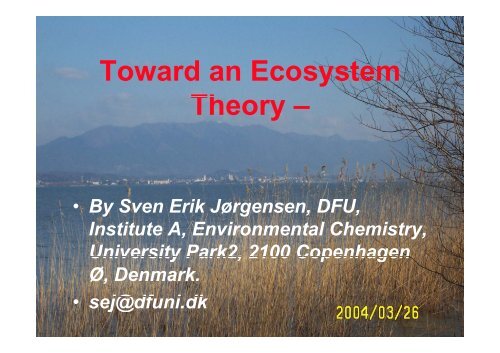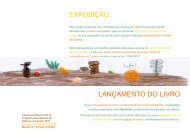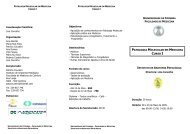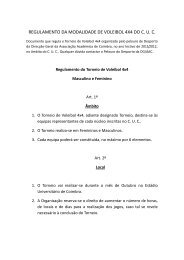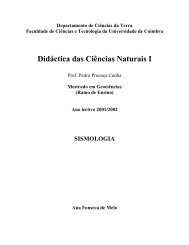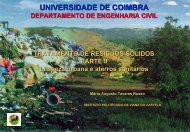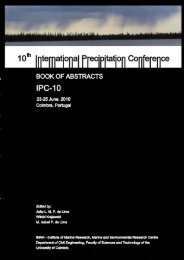Introduction to Ecosystem Theory
Introduction to Ecosystem Theory
Introduction to Ecosystem Theory
You also want an ePaper? Increase the reach of your titles
YUMPU automatically turns print PDFs into web optimized ePapers that Google loves.
Toward an <strong>Ecosystem</strong><strong>Theory</strong> –• By Sven Erik Jørgensen, DFU,Institute A, Environmental Chemistry,University Park2, 2100 CopenhagenØ, Denmark.• sej@dfuni.dkdk
Outlines:• 1)Presentation of the basic laws in antentative ecosystem theory• 2) Presentation of an Ecological Law ofThermodynamics denoted ELT byintroduction of eco-exergy• 3) Application of the theory <strong>to</strong> a) explainecological observations or rules b) <strong>to</strong>develop structurally dynamic models• 4) The theory is consistent with otherapproaches: we have an ecosystemtheory• 5) Conclusions: let use this ecosystemtheory more widely
A WORLD EQUATION ????THE BASIC LAWSNEWTON’SMAXWELL’S EINSTEIN’SSLAWSLAW OF E-RELATIVITYLECTRICITY THEORIESQUANTUMTHEORYTHERMODYNA-MIC LAWSLAWS OFRADIATIONA number of laws, cove-ring many physical relationshipsALL POSSIBLE OBSERVATIONS
1. Ecological Law:• Mass and energy conservations arevalid for ecosystem.• This law is used widely in ecologicalmodelling, population dynamics, bythe allometric principles and in theexplanation of numerous ecologicalobservations
2. Ecological Law:• All processes in ecosystems areirreversible and are accompanied byentropy production and exergydestruction.• This law gives an understanding of theenergy utilization in ecosystems, heatproduction by respiration and all energybalances for ecosystems or organisms• Irreversibility (time arrow) is a prerequisitefor the ecosystem development, theevolution and the his<strong>to</strong>ry (Prigogine).
3. Ecological Law• All ecosystems are open systemembedded in their environment. Theyreceive energy - matter anddischarge energy (heat) -matteroutput• This law explains that ecosystemscan stay far away fromthermodynamic equilibrium in spiteof the second law. <strong>Ecosystem</strong>s mustbe open <strong>to</strong> respect the 2. Ecological
Openness can be quantifiedas:Periphery / area or surfacearea / volume• The openness determines howvulnerable the system is• The openness determines how fastan ecosystem can recovered afterdestruction• The openness determine the relativeemigration and immigration rate
Disturbances: scale and recoveryVi<strong>to</strong>usek, P.M. 1994. Ecology 75: 1861-1876.
4. Ecological Law• <strong>Ecosystem</strong>s operate and are organizedhierarchically• The properties of a population aredetermined by the properties of theindividuals and the population isinfluencing the properties of theindividuals• The law is widely used <strong>to</strong> understand theproperties p of a focal level in theecological hierarchy
The organism: a result of the sumof the functionsof the organsOrgan level:specific function forthe organismThe life conditionof the organismdetermine the functionability of theorgansCell level:small biochemicalfac<strong>to</strong>riesThe organ controls thebiochemistry of the cellsMolecular level:biochemistryThe cell controls thebiochemical i processes
5. Ecological Law• The components in an ecosystemform a complex interactive, selforganizingg ecological network• This law is widely used <strong>to</strong> explainecosystem reactions. It is thereforealso used <strong>to</strong> overview ecosystemreactions in form of conceptualdiagrams, that are the basis fordevelopment of ecological models
This law has been used widely byPatten et al. To understand theproperties of ecological networks• Indirect effects are often≥directeffects• The input-output t t relationships• Energy and information, not onlymass recycle• The network can explain synergisticeffects; compare with the Gayahypothesis• <strong>Ecosystem</strong>s have his<strong>to</strong>ry that isdecisive for the reactions and
6. Ecological Law• <strong>Ecosystem</strong>s and their components(the organisms) have a characteristictibiochemistry, that is able <strong>to</strong> explainthe elementary ratio of organismsand ecosystems (≈ 25 elements), thatvaries surprisingly i little fromecosystem <strong>to</strong> ecosystem and fromorganism <strong>to</strong> organism.• Redfield ratio: C:N:P = 48:7:1.• Explanation of s<strong>to</strong>ichiometry ofecological reactions
7. Ecological Law• Carbon based life requires 250-350 K, where there is a balancebetween ordering anddisordering processes• Notice at 0K: no disorder and noordering processes
8. Ecological Law:• <strong>Ecosystem</strong>s have a complexdynamics. They can grow anddevelop by three growth forms:• Growth of biomass (the physicalstructure of the organisms) I• Growth of the network II• Growth of information III
What is exergy?• Exergy is work capacity - energy that cando work. It can therefore be found as thegradient (= difference in potential)xextensive descrip<strong>to</strong>r , dependent d on theenergy form, for instance• Chemical energy= (µ 1 -µ 2 ) N or• Pressure energy= (p 1 -p 2 )(-V))• Potential energy= (h 1 -h 2 ) m g• Electrical energy= (V 1 - V 2 )Q
We may distinguishbetween technologicalexergy and eco-exergy:• Technological l exergy uses theenvironment as reference state andis useful <strong>to</strong> find the first class energy(work) that a power plant canproduce• Eco-exergy uses as reference statethe same ecosystem with the sametemperature e and pressure e but atthermodynamic - chemicalequilibrium
System at T, pDisplacement work,not usefulWork (exergy)Reference environmentat T, p
How <strong>to</strong> find the eco-exergy?• i=n i=n• Ex = ∑(µ 1 - µ 2 ) C i = RT ∑ C i ln C i / C i,o• i=0 i=0• n• A=∑c i p i =c i /A• i=1•n•Ex = A RT ∑pi ln pi / pio + A ln A /Ao = ARTK,i=1• where K is Kullbach’s measure of information
Free Energy and Eco-exergy• Eco-exergy seems <strong>to</strong> be just a difference infree energy, but it is not the case, because• 1) The reference state is different from case<strong>to</strong> case• 2) Eco-exergy is not a state function. Noticethe difference in eco-exergy between a livingand ddead dorganism is the enormouscontribution from information. Eco-exergy cantherefore not be differentiated.• 3) Eco-exergy is the biomass (containing freeenergy) times the information.
9. Ecological Law (ELT I):• A system that receives a through-flow ofexergy (free energy) (for instance solarradiation for an ecosystem) will utilize theexergy (free energy) <strong>to</strong> move away fromthermodynamic equilibrium = gain exergy• We know that the ecosystem reactions <strong>to</strong>development are in accordance with E.POdum’s attributes, that are in accordancecewith growth forms I, II and III and we knowthat all three growth forms implyincreased exergy, so the 9. Ecological Lawmust be valid
10. Ecological Law: (ELT II)• If the ecosystem is offered morepathways or combinations ofpathways <strong>to</strong> move away fromthermodynamic equilibrium, then thecombinations of pathways that movethe system most away fromthermodynamic equilibrium / yieldthe highest eco-exergy of theecosystem, will win.• A thermodynamic translation ofDarwin ≈ survival of the fittest can beexpressed as ART K where A is the
Stability concepts have <strong>to</strong> bequantitative <strong>to</strong> be useful (R.Margalef)• Buffer capacity (or resistance capacity) =Δ forcing function (impact) / Δ state variable.Notice it is a multidimensional concept (manycombinations of forcing functions and statetvariables).• Eco-exergy for models is proportional <strong>to</strong> thesum of many buffer capacities• High biodiversity implies an increasedprobability for a wider spectrum of buffercapacities
Reaction kJ/mole e-ATP's/mole e-________________________________________________________CH2O + O2 >CO2+H2O125 298 2.98CH2O + 0.8 NO3– + 0.8 H+ CO2 + 0.4 N2 + 1.4 H2O119 2.83CH2O + 2 MnO2 + H+ CO2 + 2 Mn 2+ + 3 H2O85 2.02CH2O + 4 FeOOH + 8 H+ CO2 + 7 H2O + Fe2+27 0.64CH2O + 0.5 SO42– + 0.5 H+ CO2 + 0.5 HS– + H2O26 0.62CH2O + 0.5 CO2 CO2 + 0.5 CH423 0.55_________________________________________________________
What is the eco-exergy exergy ofhigh molecular organics?•-∆G =RTlnK.• –∆G = - 18.7 kJ/g *104400g/mole = 1952 MJ / mole = 8.2J /mole *300 lnK,• which implies that lnK = -793496 or K is about 10 -344998
How <strong>to</strong> find the eco-exergyexergycontent of living organism?• Eco-exergy = ∑ßI*ci,• Where ß is a weighting fac<strong>to</strong>r = RT lnci/cio, considering what the probability is<strong>to</strong> form the organism at thermodynamicequilibrium, ie. How many amino acidsin the right sequence is required <strong>to</strong>make up the organism, i.e how muchinformation does an organism contain?
ß-values found from thegenome sizes I• Organisms Genome Mb Repeat % ß• Human 2900 46 2149• Mouse 2500 38 2127• Tiger fish 400 9 499• Mosqui<strong>to</strong> 280 16 322• Squirt 155 10 191• Fruit fly 137 2 184• Yeast 12 2 16• Amoeba 34 0.5 46
ß-values found from thegenome sizes I• Organisms Genome Mb Repeat % ß• Human 2900 46 2155• Mouse 2500 38 2127• Worm 97 0.5 153• Mustard weed 128 14 147• Rice 400 50 275• Virus 1.01• Reptiles 833*)• Birds 980*)• *) found indirectly
Circulation rates ofnutrients as function ofrelative concentrations ofRnutrients?2.5 +2.0++1.0 +++0.50.5 1.0 1.5 2.0Log (N / P)
Structurally dynamicmodels:• Are able <strong>to</strong> account foradaptation and shift in speciescomposition• The model can assist us in theunderstanding of observedstructural changes• The model can explain when itwill be a success and when it bea failure <strong>to</strong> applybiomanipulation
External fac<strong>to</strong>rsForcingfunctionsNew recombinationsof genes /mutations<strong>Ecosystem</strong> stemstructure at time tGene poolSelection<strong>Ecosystem</strong>structure at timet+1
Galilei: measure everythingand what is not measurablemake measurable
Galilei modified: modeleverything and, what is notmodelable make modelable
PREVAILING CONDITION 1STRUCTURE 1The structure is changed, because theprevailing conditions are changed - andadaptation and/or shifts in species com-position can give a better survival inthe Darwinian sense. Survival is measuredas biomass and information -therefore exergy can be applied as goalfunctionPREVAILING CONDITION 2EXERGY ISUSED ASGOAL FUNC-TION TO DE-TERMINE THESTRUCTURALCHANGESSTRUCTURE 2
Select parameters based upon literaturestudies and according <strong>to</strong> speciescompositionSelect most crucial parameters, symbolizedby parameter vec<strong>to</strong>r PTest after time step t all combinations ofall the selected parameters +/- x%, y% etci.e. at least three leves for each parameter.The <strong>to</strong>tal number of combinations <strong>to</strong> be e-xamined is l n, where l is the number of levelsand n is the number of parameters inthe parameter vec<strong>to</strong>r P. The combinationgiving the highest exergy is used for thesimulation during the considered time stepTest after time step n*t all combinations ofTest after time step n t all combinations ofthe selected parameters +/- x%, y% etc.The combination giving the highest exergyis used for the simulation duringe the consideredtime step
Eutrophication, (measured by phy<strong>to</strong>primary production)plank<strong>to</strong>n conc. orRange, wherebiomanipulationnot isappliedRange, where biomanipulationcan be appliedFaster recoveryobtain-ed by bio-maipulationRange, wherebiomanipulationhardly can beappliedNutrient concentration
Two structures arecompeting:• Below 60 µg P/l zooplank<strong>to</strong>n andcarnivorous fish dominanceAbove 125µg P/l phy<strong>to</strong>plank<strong>to</strong>n andplanktivorous fishBetween 60 and 125µg P/l bothstructures are possible dependen<strong>to</strong>n the his<strong>to</strong>ry
Shallow lakes have twocompeting structures, <strong>to</strong>o:• Below about100 µg P /l submergedvegetation is dominant• Above about 250µg P/l phy<strong>to</strong>plank<strong>to</strong>nis dominant• Between about 100 and 250 µg P/l thetwo structures are both possible,dependent on the his<strong>to</strong>ry
Results obtained by astructurally dynamic model:1412P_SP (g/m^ ^2)10864200 0.1 0.2 0.3 0.4 0.5 0.6TP (m g P/l )
We have three growth forms•1) Biomass - physicalyscastructure• 2) The network• 3) The informationNotice that they summarizethe E.P. Odum’s attributest
Growthforms2and3arearedifferent from growth form 1:• They are not following theconservation principlesi • An ecological network has morepositive than negative relations• Information can be copied at almostno cost• The two growth forms are far fromtheir limits
It has been examined by useof models and ecologicalknowledge / E.P. Odums,• How the exergy, specific exergy= exergy / biomass, exergydestruction (The Extended 2.Law), power,, entropyproduction, change with thegrowth forms I, II and III.
Growth AB C D ESpec. entropy Power Exergy de- Exergy s<strong>to</strong>- RetentionProduction struction rage time_________________________________________________________________________I unchanged(-) increases(+) increases(+) increases(+)increases(+)II decreases(+) increases(+) unchanged(-) increases(+)increases(+)III decreases(+) increases(+) unchanged(-) increases(+)increases(+)_________________________________________________________________________
100806040*** * * *200*0 20 40 60Exergy (MJ / m 2 )
umbers180 ..RegenerationJuvenileOptimum. .MixedExergy de estruction,relative n160140. Gap. Pasture120 0 5 10 15 20 25 30 35 40Exergy s<strong>to</strong>red (GJ / ha)
Recently at a brains<strong>to</strong>rming meetingon the Danish Island Møn, it waspossible <strong>to</strong> “hang” these 10 laws on 5ecosystem properties:
Recently at a brains<strong>to</strong>rming meetingon the Danish Island Møn, it waspossible <strong>to</strong> “hang” these 10 laws on 5ecosystem properties:
Recently at a brains<strong>to</strong>rming meetingon the Danish Island Møn, it waspossible <strong>to</strong> “hang” these 10 laws on 5ecosystem properties:1. <strong>Ecosystem</strong>s have directionality2. <strong>Ecosystem</strong>s are open systems3. <strong>Ecosystem</strong>s have connectivity4. <strong>Ecosystem</strong>s have emergenthierarchies5. <strong>Ecosystem</strong>s have complexdynamics
We do have an ecosystem theory!Why do we not apply this theorymore widely in ecology andenvironmental sciences?• It should be applied <strong>to</strong>explain ecologicalobservations and used as<strong>to</strong>ol in ecologicalengineering!!
<strong>Ecosystem</strong> <strong>Theory</strong> books:• S.E. Jørgensen. Integration of<strong>Ecosystem</strong> Theories: A Pattern,Kluwer, Third edition, 2002.• S.E.Jørgensen and Y.SvirezhevToward a Thermodynamic <strong>Theory</strong> forEcological Systems. Elsevier. 2004.
CONCLUSIONS• We do have an ecosystem theory-orrather a pattern of ecosystemtheories. It is still underdevelopment, but is sufficientlydeveloped <strong>to</strong> day <strong>to</strong> be applied,as it has been shown.We ought <strong>to</strong> apply it more widelyWe ought <strong>to</strong> apply it more widelyin ecology
THANK YOU FOR YOURATTENTION
Than you for your attention


